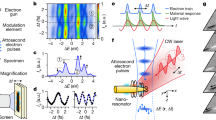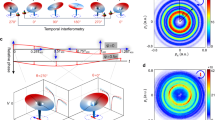Abstract
The subcycle interaction of light and electrons has been one of the key frontiers in free-electron lasers, attosecond science and dynamical investigation of matter. Capturing the underlying subcycle dynamics of electrons with an optical field promises fascinating vistas with unprecedented temporal resolution. Yet the rigorous synchronization requirement has kept its realization out of reach. Here, by direct spatial observation of periodic electron bunch fringes, we demonstrate a laser streaking concept for revealing the dynamics of free electrons emitted from a plasma mirror under sub-relativistic laser intensity. Field-induced electron beam deflection demonstrates subcycle charge dynamics with a streaking speed of ~60 μrad as−1. This provides us with an attosecond-resolution metrology to obtain more direct evidence about the light-field-induced electron dynamics in the plasma mirror. Our results offer unprecedented characterization of attosecond dynamics and open the way to extensive experimental investigations of the interaction of attosecond electrons with intense lasers.
This is a preview of subscription content, access via your institution
Access options
Access Nature and 54 other Nature Portfolio journals
Get Nature+, our best-value online-access subscription
$29.99 / 30 days
cancel any time
Subscribe to this journal
Receive 12 print issues and online access
$209.00 per year
only $17.42 per issue
Buy this article
- Purchase on Springer Link
- Instant access to full article PDF
Prices may be subject to local taxes which are calculated during checkout




Similar content being viewed by others
Data availability
All relevant data are available from the corresponding authors upon reasonable request.
Code availability
The codes that support the plots within this paper and other findings of this study are available from the corresponding authors upon reasonable request.
References
Kapitza, P. L. & Dirac, P. A. M. The reflection of electrons from standing light waves. Math. Proc. Camb. Phil. Soc. 29, 297–300 (1933).
Bucksbaum, P. H., Schumacher, D. W. & Bashkansky, M. High-intensity Kapitza–Dirac effect. Phys. Rev. Lett. 61, 1182–1185 (1988).
Krausz, F. & Ivanov, M. Attosecond physics. Rev. Mod. Phys. 81, 163–234 (2009).
Zewail, A. H. Four-dimensional electron microscopy. Science 328, 187–193 (2010).
Sciaini, G. & Miller, R. J. D. Femtosecond electron diffraction: heralding the era of atomically resolved dynamics. Rep. Prog. Phys. 74, 096101 (2011).
Barwick, B., Park, H. S., Kwon, O. H., Baskin, J. S. & Zewail, A. H. 4D imaging of transient structures and morphologies in ultrafast electron microscopy. Science 322, 1227–1231 (2008).
Kassier, G. H. et al. A compact streak camera for 150-fs time resolved measurement of bright pulses in ultrafast electron diffraction. Rev. Sci. Instrum. 81, 105103 (2010).
Kirchner, F. O., Gliserin, A., Krausz, F. & Baum, P. Laser streaking of free electrons at 25 keV. Nat. Photon. 8, 52–57 (2013).
Emma, P. et al. First lasing and operation of an ångstrom-wavelength free-electron laser. Nat. Photon. 4, 641–647 (2010).
Schlenvoigt, H. P. A compact synchrotron radiation source driven by a laser-plasma wakefield accelerator. Nat. Phys. 4, 130–133 (2008).
Niikura, H. et al. Probing molecular dynamics with attosecond resolution using correlated wave packet pairs. Nature 421, 826–829 (2003).
Borot, A. et al. Attosecond control of collective electron motion in plasmas. Nat. Phys. 8, 416–421 (2012).
Zewail, A. H. 4D ultrafast electron diffraction, crystallography and microscopy. Annu. Rev. Phys. Chem. 57, 65–103 (2006).
Kealhofer, C. et al. All-optical control and metrology of electron pulses. Science 352, 429–433 (2016).
van Oudheusden, T. et al. Compression of subrelativistic space-charge-dominated electron bunches for single-shot femtosecond electron diffraction. Phys. Rev. Lett. 105, 264801 (2010).
Maxson, J. et al. Direct measurement of sub-10-fs relativistic electron beams with ultralow emittance. Phys. Rev. Lett. 118, 154802 (2017).
Hassan, M. T., Baskin, J. S., Liao, B. & Zewail, A. H. High-temporal-resolution electron microscopy for imaging ultrafast electron dynamics. Nat. Photon. 11, 425–430 (2017).
Morimoto, Y. & Baum, P. Diffraction and microscopy with attosecond electron pulse trains. Nat. Phys. 14, 252–256 (2018).
Priebe, K. E. et al. Attosecond electron pulse trains and quantum state reconstruction in ultrafast transmission electron microscopy. Nat. Photon. 11, 793–797 (2017).
Hentschel, M. et al. Attosecond metrology. Nature 414, 509–513 (2001).
Itatani, J. et al. Attosecond streak camera. Phys. Rev. Lett. 88, 173903 (2002).
Zhang, D. et al. Segmented terahertz electron accelerator and manipulator (STEAM). Nat. Photon. 12, 336–342 (2018).
Zhao, L. R. et al. Terahertz oscilloscope for recording time information of ultrashort electron beams. Phys. Rev. Lett. 122, 144801 (2019).
Woodward, P. M. A method of calculating the field over a plane aperture required to produce a given polar diagram. J. Inst. Electr. Eng. 93, 1554–1558 (1946).
Lawson, J. D. Lasers and accelerators. IEEE Trans. Nucl. Sci. 26, 4217–4219 (1979).
Tian, Y. et al. Electron emission at locked phases from the laser-driven surface plasma wave. Phys. Rev. Lett. 109, 115002 (2012).
Thevenet, M. et al. Vacuum laser acceleration of relativistic electrons using plasma mirror injectors. Nat. Phys. 12, 355–360 (2016).
Quéré, F. et al. Coherent wake emission of high-order harmonics from overdense plasmas. Phys. Rev. Lett. 96, 125004 (2006).
Thaury, C. et al. Coherent dynamics of plasma mirrors. Nat. Phys. 4, 631–634 (2008).
Zhang, Z. et al. The 1-PW/0.1-Hz laser beamline in SULF facility. High Power Laser Sci. Eng. 8, e4 (2020).
Yu, L. P. et al. High-contrast front end based on cascaded XPWG and femtosecond OPA for 10-PW-level Ti:sapphire laser. Opt. Express 26, 2625–2633 (2018).
Arber, T. D. et al. Contemporary particle-in-cell approach to laser-plasma modelling. Plasma Phys. Control. Fusion 57, 113001 (2015).
Gibbon, P. Short Pulse Laser Interactions with Matter: An Introduction (Imperial College Press, 2005).
Acknowledgements
This work was sponsored by the National Natural Science Foundation of China (grants nos 11874372, 11922412 and 11974251), Shanghai Sailing Program (grant no. 20YF1454900), Strategic Priority Research Program (B) (grant no. XDB16), Shanghai Rising-Star Program, Shanghai Commission of Science and Technology (no. 19PJ1410500), the 100 Talents Program of CAS, the Youth Innovation Promotion Association of Chinese Academy of Sciences and the Key Research Program of Frontier Sciences, CAS, grant no. ZDBS-LY-SLH018.
Author information
Authors and Affiliations
Contributions
C.Z., Y.B. and Y. T. performed the experiment. C.Z., Y.B., L.S., Y.Z. and D.Z. analysed the data with Y.T., J.L, R.L and Z.X.; C.Z. performed the PIC simulations. Y.B. and Y.T. developed the test particle model. Y.X., X.L. and Y.L. developed and maintained the laser sources. All authors participated in the interpretation of the results. C.Z., Y.Z. and Y.T. wrote the manuscript. R.L., J.L. and Y.T. designed and directed the project.
Corresponding authors
Ethics declarations
Competing interests
The authors declare no competing interests.
Additional information
Peer review information Nature Photonics thanks Mohammed Hassan, Hidemi Shigekawa and the other, anonymous, reviewer(s) for their contribution to the peer review of this work.
Publisher’s note Springer Nature remains neutral with regard to jurisdictional claims in published maps and institutional affiliations.
Supplementary information
Supplementary Information
Supplementary Figs. 1–3 and Discussion.
Rights and permissions
About this article
Cite this article
Zhou, C., Bai, Y., Song, L. et al. Direct mapping of attosecond electron dynamics. Nat. Photonics 15, 216–221 (2021). https://doi.org/10.1038/s41566-020-00730-6
Received:
Accepted:
Published:
Issue Date:
DOI: https://doi.org/10.1038/s41566-020-00730-6



